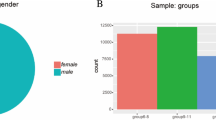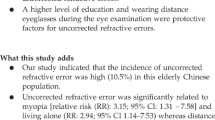Abstract
Purpose
To investigate the prevalence and factors associated with uncorrected presbyopia among rural community dwellers in Japan.
Study design
A population-based cross-sectional study was conducted in 2011 among community dwellers aged 40–74 years who received specific health checkups in Minamiaizu and Tadami, Fukushima Prefecture, Japan.
Methods
Uncorrected presbyopia was considered as when the distance-corrected visual acuity in the better eye was ≥0.5 and the near-presenting visual acuity in the better eye was <0.4, regardless of distance refractive status. Multiple logistic regression analysis was employed to calculate the odds ratios (ORs) for uncorrected presbyopia and to adjust for possible confounders.
Results
A total of 2054 individuals participated in the specific health checkups. In the 1156 individuals (response rate: 56.28%) analyzed in the study, the mean (SD) age was 63.0 (8.7) years, the percentage of women was higher (57.87%), and the prevalence of uncorrected presbyopia was 26.38% (95% CI 23.86%–29.03%). Multivariate analysis revealed that the factors associated with uncorrected presbyopia were older age (adjusted OR: 1.054 [95% CI: 1.034–1.075]), female sex (adjusted OR: 1.388 [95% CI: 1.006–1.915]), and distance-presenting vision impairment (adjusted OR: 2.651 [95% CI: 1.697–4.143]).
Conclusion
Approximately one-quarter of the participants in this study from a rural population of Japan did not have adequate near vision. It is recommended that a public health intervention should be enacted to correct presbyopia, especially in the older age group, women, and those with uncorrected refractive errors.


Similar content being viewed by others
References
World Health Organization. List of Official ICD-10 updates ratified october 2006. World Health Organization; 2006. http://www.who.int/classifications/icd/2006Updates.pdf. Accessed 1 Nov 2020
World Health Organization. Blindness and vision impairment. World Health Organization. 2016. https://www.who.int/news-room/fact-sheets/detail/blindness-and-visual-impairment. Accessed 1 Nov 2020
Fricke TR, Tahhan N, Resnikoff S, Papas E, Burnett A, Ho SM, et al. Global prevalence of presbyopia and vision impairment from uncorrected presbyopia: systematic review, meta-analysis, and modelling. Ophthalmology. 2018;125:1492–9.
Wolffsohn JS, Davies LN. Presbyopia: effectiveness of correction strategies. Prog Retin Eye Res. 2019;68:124–43.
Otani K, Takegami M, Fukumori N, Sekiguchi M, Onishi Y, Yamazaki S, et al. Locomotor dysfunction and risk of cardiovascular disease, quality of life, and medical costs: design of the Locomotive Syndrome and Health Outcome in Aizu Cohort Study (LOHAS) and baseline characteristics of the study population. J Orthop Sci. 2012;17:261–71.
Ono R, Yamazaki S, Takegami M, Otani K, Sekiguchi M, Onishi Y, et al. Gender difference in association between low back pain and metabolic syndrome: locomotive syndrome and health outcome in Aizu cohort study (LOHAS). Spine (Phila Pa 1976). 2012;37:1130–7.
Kurita N, Yamazaki S, Fukumori N, Otoshi K, Otani K, Sekiguchi M, et al. Overactive bladder symptom severity is associated with falls in community-dwelling adults: LOHAS study. BMJ Open. 2013;3:e002413.
Tano T, Ono K, Hiratsuka Y, Otani K, Sekiguchi M, Konno S, et al. Prevalence of pterygium in a population in Northern Japan: the Locomotive Syndrome and Health Outcome in Aizu Cohort Study. Acta Ophthalmol. 2013;91:e232–6.
Tano T, Ono K, Hiratsuka Y, Otani K, Sekiguchi M, Konno S, et al. Retinal vessel diameters in a Japanese population: the Locomotive Syndrome and Health Outcome in Aizu Cohort Study. Acta Ophthalmol. 2016;94:e432–41.
Niihata K, Fukuma S, Hiratsuka Y, Ono K, Yamada M, Sekiguchi M, et al. Association between vision-specific quality of life and falls in community-dwelling older adults: LOHAS. PLoS ONE. 2018;13:e0195806.
Fukuhara S, Wakita T, Yamada M, Hiratsuka Y, Green J, Oki K. Development of a short version of the visual function questionnaire using item-response theory. PLoS ONE. 2013;8:e73084.
Hiratsuka Y, Yamada M, Akune Y, Murakami A, Okada AA, Yamashita H, et al. Assessment of vision-related quality of life among patients with cataracts and the outcomes of cataract surgery using a newly developed visual function questionnaire: the VFQ-J11. Jpn J Ophthalmol. 2014;58:415–22.
Bourne RRA, Flaxman SR, Braithwaite T, Cicinelli MV, Das A, Jonas JB, et al. Magnitude, temporal trends, and projections of the global prevalence of blindness and distance and near vision impairment: a systematic review and meta-analysis. Lancet Glob Health. 2017;5:e888–97.
United Nations. Department of Economics and Social Affairs: population dynamics. https://population.un.org/wpp/Download/Standard/Population/. Accessed 15 Dec 2020.
Kozaki M. Jyakushi renzu no shohou to shiyou: kaigyoui no tame no. Ganka. 1965;7:893–909.
WHO Programme for the Prevention of Blindness and Deafness. Consultation on development of standards for characterization of vision loss and visual functioning: World Health Organization. 2003. https://apps.who.int/iris/bitstream/handle/10665/68601/WHO_PBL_03.91.pdf?sequence=1&isAllowed=y. Accessed 1 Nov 2020
Li Z, Xu K, Wu S, Sun Y, Song Z, Jin D, et al. Alcohol consumption and visual impairment in a rural Northern Chinese population. Ophthalmic Epidemiol. 2014;21:384–90.
Han X, Lee PY, Keel S, He M. Prevalence and incidence of presbyopia in urban Southern China. Br J Ophthalmol. 2018;102:1538–42.
Lu Q, He W, Murthy GV, He X, Congdon N, Zhang L, et al. Presbyopia and near-vision impairment in rural northern China. Invest Ophthalmol Vis Sci. 2011;52:2300–5.
Brian G, Pearce MG, Ramke J. Refractive error and presbyopia among adults in Fiji. Ophthalmic Epidemiol. 2011;18:75–82.
Marmamula S, Khanna RC, Kunuku E, Rao GN. Near visual impairment and spectacle coverage in Telangana. India Clin Exp Ophthalmol. 2017;45:568–74.
Marmamula S, Khanna RC, Narsaiah S, Shekhar K, Rao GN. Prevalence of spectacles use in Andhra Pradesh, India: rapid assessment of visual impairment project. Clin Exp Ophthalmol. 2014;42:227–34.
Marmamula S, Madala SR, Rao GN. Prevalence of uncorrected refractive errors, presbyopia and spectacle coverage in marine fishing communities in South India: Rapid Assessment of Visual Impairment (RAVI) project. Ophthalmic Physiol Opt. 2012;32:149–55.
Nirmalan PK, Krishnaiah S, Shamanna BR, Rao GN, Thomas R. A population-based assessment of presbyopia in the state of Andhra Pradesh, south India: the Andhra Pradesh Eye Disease Study. Invest Ophthalmol Vis Sci. 2006;47:2324–8.
Hashemi H, Khabazkhoob M, Jafarzadehpur E, Mehravaran S, Emamian MH, Yekta A, et al. Population-based study of presbyopia in Shahroud, Iran. Clin Exp Ophthalmol. 2012;40:863–8.
Sapkota YD, Dulal S, Pokharel GP, Pant P, Ellwein LB. Prevalence and correction of near vision impairment at Kaski, Nepal. Nepal J Ophthalmol. 2012;4:17–22.
Ramke J, Brian G, Naduvilath T. Refractive error and presbyopia in Timor-Leste: the impact of 5 years of a national spectacle program. Invest Ophthalmol Vis Sci. 2012;53:434–9.
Taylor HR, Livingston PM, Stanislavsky YL, McCarty CA. Visual impairment in Australia: distance visual acuity, near vision, and visual field findings of the Melbourne Visual Impairment Project. Am J Ophthalmol. 1997;123:328–37.
Kidd Man RE, Fenwick EK, Sabanayagam C, Li LJ, Gupta P, Tham YC, et al. Prevalence, correlates, and impact of uncorrected presbyopia in a multiethnic Asian population. Am J Ophthalmol. 2016;168:191–200.
Andualem HB, Assefa NL, Weldemichael DZ, Tefera TK. Prevalence and associated factors of presbyopia among school teachers in Gondar city, Northwest Ethiopia, 2016. Clin Optom (Auckl). 2017;9:85–90.
Fan AZ, Li Y, Zhang X, Klein R, Mokdad AH, Saaddine JB, et al. Alcohol consumption, drinking pattern, and self-reported visual impairment. Ophthalmic Epidemiol. 2012;19:8–15.
Saito T, Kondo K, Murata C, Jeong S, Suzuki K, Kondo N, et al. Gender and regional differences in going-out, social, and leisure activities among older adults: findings from the JAGES Project. Nihon Koshu Eisei Zasshi. 2015;62:596–608 (in Japanese).
Acknowledgements
This work was supported by grants from the Ministry of Health, Labor and Welfare, Japan (19AA2007, 20AA2005, and 19FA1010) and the Ministry of Education, Culture, Sports, Science and Technology, Japan (20H03907). The funding organizations had no role in the design or conduct of this research.
Author information
Authors and Affiliations
Corresponding author
Ethics declarations
Conflicts of interest
Y. Sadamatsu, None; K. Ono, None; Y. Hiratsuka, None; A. Takesue, None; T. Tano, None; M. Yamada, None; K. Otani, None; M. Sekiguchi, None; S. Konno, None; S. Kikuchi, None; S. Fukuhara, None; A. Murakami, None.
Additional information
Publisher's Note
Springer Nature remains neutral with regard to jurisdictional claims in published maps and institutional affiliations.
Corresponding Author: Koichi Ono
About this article
Cite this article
Sadamatsu, Y., Ono, K., Hiratsuka, Y. et al. Prevalence and factors associated with uncorrected presbyopia in a rural population of Japan: the Locomotive Syndrome and Health Outcome in Aizu Cohort Study. Jpn J Ophthalmol 65, 724–730 (2021). https://doi.org/10.1007/s10384-021-00863-3
Received:
Accepted:
Published:
Issue Date:
DOI: https://doi.org/10.1007/s10384-021-00863-3




